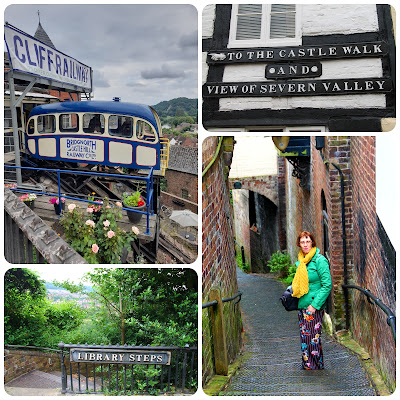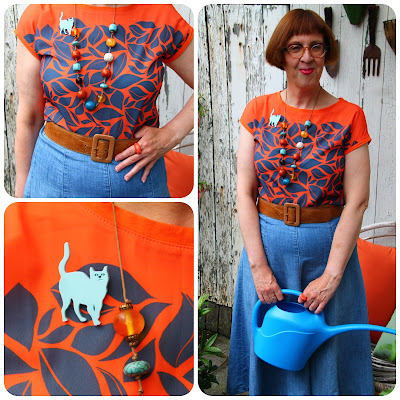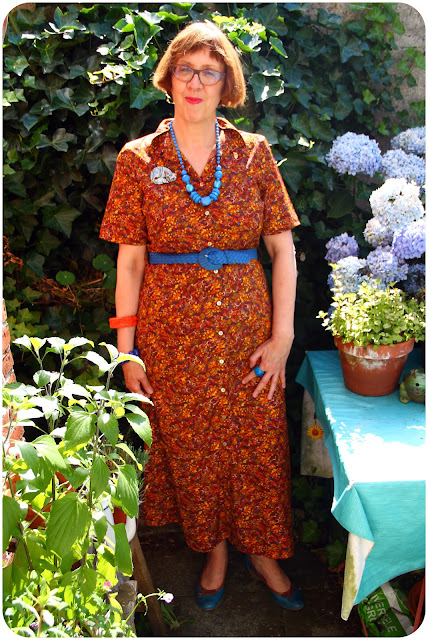With the advent of a short but searing heatwave here in Belgium and elsewhere in Europe, culminating in temperatures of nearly 40°C on Tuesday, it has been too hot to think, let alone write a cohesive blog post.
So, I'm taking a short break from my travelogue and thought I'd do a catch-up on what's been happening in my life - and what I've been wearing, obviously - since we came back from our UK holiday instead.
In between unpacking, laundering and catching up with blogland on Sunday the 3rd of July, Bess claimed our laps whenever we dared to take a breather.
If she had only recently discovered the joys of napping on our laps in the weeks before our holiday, she now seemed to be determined to make up for lost time. Not having had a lap cat before, this is quite a revelation, but the problem is that once she's made herself comfortable you must be prepared to stay put for a while. But what a joy she brings to our lives. Never mind the needles and pins, or her sharp claws ...
It was a good thing I'd taken Monday off as well, as the garden, and in particular the poor patio pots, sorely needed some TLC.
I'd grouped together most of the pots in the passageway, giving them a thorough drenching the day before we left, but basically they'd had to fend for themselves for two weeks.
Most of them survived surprisingly well though, with only one fatal casualty. However, the majority were looking a bit straggly and had all but given up flowering, so I gave them a haircut, quenched their thirst and hoped for the best.
The orange top with its blue leafy pattern was charity shopped back in May, and for its first outing I paired it with a denim skirt I'd picked up in a Shropshire charity shop. I accessorized my outfit with my tan leather belt and multi-coloured beaded necklace, both thrifted ages ago, and one of my cat brooches, a cheeky retail buy from
Katshop, a delightful shop catering for cats and their personnel.
A stroll through the garden revealed quite a few novelties which had decided to rear their heads during our absence. There were spikes of Verbascum nigrum, its cheerful yellow flowers enhanced by contrasting pinkish-purple hearts and orange anthers (left). More yellow cheerfulness was provided by double yellow Hollyhocks (top right) and Nasturtiums in the palest of yellows. The latter were self-seeded the offspring of last's year's.
Tuesday was my first day back at the office, and as I loved Monday's outfit so much I wore it again in its entirety. As I passed the coat rack in our hallway, my eyes were drawn to the blue jacket with its pattern of orange leaves - to all intents and purposes the top's mirror image - which surely couldn't have been more perfect.
As usual, chaos reigned at the office, and it took me the better part of two days to get back on top of everything and wrestle through nearly 900 emails. Fortunately, things were back to the usual office routine by the end of the week.
More garden surprises were offered by the drumstick Alliums (Allium sphaerocephalon, top left), which seemed to have multiplied in their second year. There is Phlox 'Sweet Summer Wine' (top right) in abundance as well, but the lavender flowers of Geranium 'Rozanne' (bottom left) appear to be less plentiful than before.
Lately offering only a handful of flowers each year, any of the purple saucer-like blooms in Clematis viticella 'Etoile Violette' (bottom right) are welcomed with squeals of delight.
My outfit, worn on Wednesday, was employing a similar colour palette of blues, lavenders, purples and pinks. My cotton floral frock, with its front zip closure and solid blue collar and pocket tabs, is vintage and an old Think Twice find. Those are real pockets, by the way!
I added a tan belt with a cream lace inset at my waist, while oodles of pink were supplied by my cardigan, beaded necklace, ring and flower brooch. My rose gold sandals are by Gabor and a sales bargain in the Summer of 2019.
Helenium 'The Bishop' has been brightening up the garden with its sunshine yellow flowers for the third Summer running and it seems I'm not the only one drawn to its daisy-like flowers with their prominent brown hearts.
Legend tells that Helenium sprang from the ground, watered by the tears of Helen of Troy. Apparently, this perennial is also known as Sneezeweed, because the leaves were once used in snuff.
I can do yellow too, although this beloved Diolen frock is more of a mustard. Whatever the case, it's an instant pick-me-up for a humdrum working day.
After a string of days with temperatures hovering around the mid-twenties, the mercury dropped below 20°C on Thursday, which was the perfect excuse to wear a dress in a fabric which is a close cousin of Crimplene!
I picked out the green of the flowers in its print for my belt, necklace, ring and unusual green Cameo brooch. No sandals, but a pair of comfortable flat-heeled gold shoes. And yes, I was wearing nylons, although the weather turned out not to be too bad and I could very well have done without them.
There's something weird going on with our Salvia microphylla ‘Hot Lips’. Planted last year with great success, I initially feared it hadn't made it through Winter when finally its tiny flowers started popping up. However, apart from the usual fiery red ones with a bit of white, there were half red/half white ones, and even a couple of pure white blooms.
The white pom-poms (top right) belong to Achillea ptarmica 'The Pearl', also into its second year, as is Astrantia 'Primadonna' (bottom left) which has really come into its own this Summer, offering a plethora of ruby pincushion flowers.
Having only started on Tuesday, I forewent my usual Friday off that week, so that my weekend was only a two-day one. It couldn't have come soon enough though.
Saturday was a warm yet windy day, with the sun playing a game of hide and seek with the clouds, and highs of 21°C.
In spite of a to-do list as long as my arm, we decided the day was too good to be wasted inside, so we went for a rummage in the charity shop near the park.
I spent some time happily trawling the full to bursting rails and, having been very restrained lately, ended up buying just three items.
The blue blouse patterned with twigs and birds is by Belgian label Wow To Go. It had the most boring and annoyingly teeny-weeny blue buttons, which I replaced with slightly bigger domed green vintage ones.
Two jackets made the grade as well. The mustard blazer is by L' Histoire de Louise, which is another Belgian label, while the green speckled short-sleeved one is vintage. I suspect it originally paired with a skirt.
Afterwards, we went for a stroll and a picnic in the park. Here, there were plenty of opportunities to take outfit photos alongside the wildflower borders which seemed to have sprung up out of nowhere.
I last wore the skirt, which was an irresistible retail buy in Spring, when we visited Powis Castle. There's another link with Powis Castle in my green cotton and broderie anglaise peasant top, which is what I wore on our previous visit in June 2019. It was snapped up from New Look in the 2018 summer sales.
My bangles, necklace and brooch were all charity shopped at one time or another, while the orange belt was picked up on the high street many years ago. The red sandals were yet another sales bargain.
The latter echo the colour of the poppies in the wildflower borders almost exactly!
Apart from these there were magenta corncockles, bright blue cornflowers and yellow corn marigolds rearing their lovely heads among the high grasses while, lining the shady paths were several pinkish white lacecap Hydrangeas.
Sunday was cloudy and overcast until late afternoon. In fact, as luck would have it, the sun had just made an appearance when we were about to take outfit photos. In our sun-drenched garden, it wasn't easy to find a suitable spot.
My dress with its Autumnal millefiori pattern is from the Danish Only label and was a charity shop find last August on a particularly fruitful day. For my accessories, I picked up the bright, cornflower blue from its pattern, adding the odd splash of orange as well. The necklace, belt, bangles, ring and shoes were all thrifted, while the Lea Stein lookalike cat brooch with its orange eyes and ears, was a gift from my lovely blogging friend,
Kezzie.
With both a string of hot days and our street's flea market coming up, there was nothing for it but to tackle that to-do list.
Therefore, Sunday was spent in a frenzy of ironing wrinkled cotton Summer frocks and unearthing my boxes of surplus clothing from the depths of our hell-hole of a built-in cupboard.
To be continued, at some point.
P.S. Thankfully, it has cooled down considerably by now ...



















































